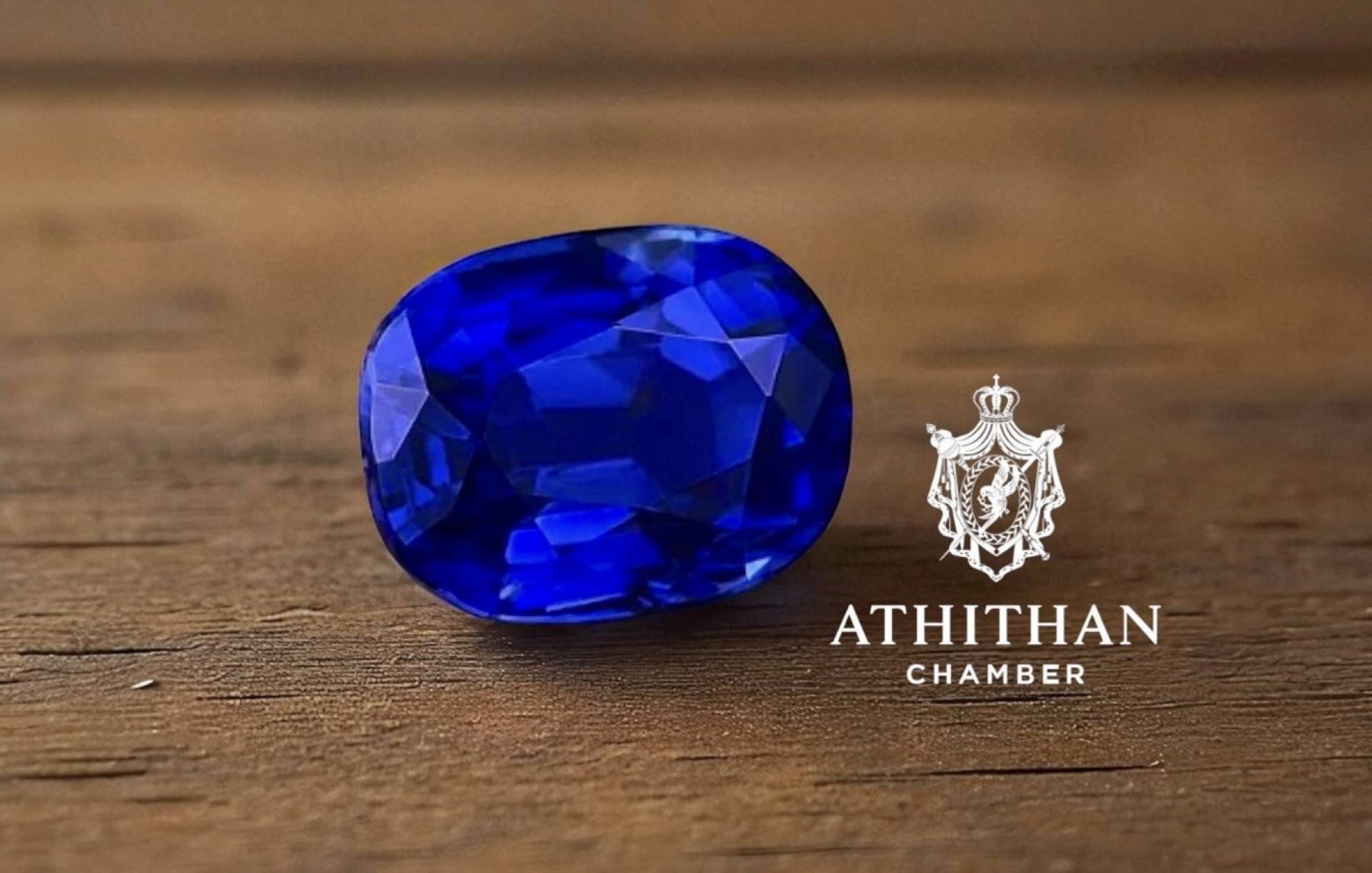The Complete Guide to Blue Sapphires

A journey through the worlds most coveted blue gem.
1) Identity of the Blue Sapphire
Scientific Name: Corundum (Chemical formula: AlO)
Hardness: 9 on the Mohs scale (second only to diamond)
Refractive Index (RI): ~1.7621.770 | Birefringence: ~0.0080.010
Specific Gravity (SG): ~3.954.05
Color Origin: Caused by electron transfer between iron (Fe) and titanium (Ti), producing the deep blue color. An excess of Fe³ may cause a darker, duller appearance.
Pleochroism: Displays different shades when viewed from different crystal directions (e.g., blue, violet, or greenish-gray). Skilled cutters orient the stone to bring out the most beautiful face-up color.
2) Origins and Geology
Each source imparts its own color tone and character, directly influencing the sapphires value and rarity.
Kashmir (India): Famous for the legendary Velvety Blue, a soft, rich hue with a silky glow caused by fine rutile inclusions. Extremely rare and highly coveted.
Sri Lanka (Ceylon): Renowned for vibrant Cornflower Blue and Royal Blue sapphires. Large, clean stones from this source are highly prized in high jewelry.
Burma (Mogok, Myanmar): Known for regal Royal Blue of exceptional depth and saturation. Rare and powerful in appearance.
Madagascar: A leading modern source, producing stones from Cornflower to Royal Blue. The finest rival those from Ceylon and Burma.
Thailand & Cambodia (Chanthaburi, Pailin): Historically important, yielding classic dark blue sapphires. Natural production is now scarce.
Montana (USA, Yogo): Typically small in size but of superb quality, often unheated, with a distinctive violetish-blue. Highly valued per carat.
Other sources (Australia, Nigeria, Tanzania, Vietnam, Laos, etc.): Produce a wide range of colors from near-black to bright blues. Fine quality exists but requires careful selection.
3) The Spectrum of Blue in Sapphires
The language of blue sapphires, from the legendary to the contemporary.
| Shade | Distinctive Features | Primary Origins | Market Value |
| Velvety Blue (Kashmir) | Rich, velvety blue with soft, silky glow | Kashmir, India | Legendary highest value |
| Royal Blue | Deep, regal, luxurious blue | Burma, Sri Lanka, Madagascar | Very high most coveted |
| Cornflower Blue | Bright, lively blue with slight violet | Sri Lanka, Montana | Very high luminous and vivid |
| Peacock Blue | Blue with greenish-peacock overtone | Sri Lanka, Madagascar, Montana | High increasingly fashionable |
| Pastel / Baby Blue | Light, delicate sky-blue | Sri Lanka, Madagascar | Mid-range |
| Sky Blue | Open, airy blue with brilliance | Sri Lanka, Madagascar | Mid-range |
| Indigo / Violetish Blue | Blue with a purplish indigo tint | Sri Lanka, Madagascar | Mid-range |
| Greenish Blue / Teal | Blue with green overtones, modern look | Montana, Madagascar | Rising in popularity |
| Midnight Blue | Very dark navy, near-black | Thailand, Cambodia, Australia | Moderate |
| Inky Blue | Dull, inky blue lacking brilliance | Australia, Africa | Lowest value |
4) Unique Phenomena
Star Sapphire: Created by aligned rutile inclusions, producing a six-rayed (sometimes twelve-rayed) star effect when cut en cabochon.
Color-change Sapphire: Exhibits a shift from blue in daylight to violet or pink under incandescent light.
Kashmirs Velvety Glow: The legendary soft, velvety effect caused by microscopic silk inclusions, giving Kashmir sapphires their unmatched mystique.
5) Value Determinants
Color: The single most important factor.
Untreated (Unheated): Commands the highest premium.
Origin: Prestige hierarchy Kashmir > Burma / Ceylon > Madagascar > Other sources.
Carat Weight: Prices leap significantly at thresholds (2 ct, 5 ct, 10 ct, etc.).
Clarity & Inclusions: Greater transparency increases value, though fine rutile silk can enhance beauty in certain stones.
Cut: Must avoid windows (areas of weak color) and extinction (dark patches).
Shape: Cushion and oval cuts are most favored for bringing out optimal color.
6) Laboratories and Certification of Blue Sapphires
Certification is essential in the high-value sapphire market. A laboratory report provides:
Authentication confirming the stone is natural sapphire.
Treatment disclosure identifying whether the stone is unheated, heat-only, or subjected to other enhancements.
Origin determination indicating whether the sapphire is from Kashmir, Burma, Sri Lanka, Madagascar, etc., which directly affects value and prestige.
In auctions and private collections, a laboratory certificate is indispensable for trust and market confidence.
Leading Laboratories
GIA (Gemological Institute of America): The most respected for scientific accuracy.
SSEF (Swiss Gemmological Institute): Based in Switzerland with the highest prestige in Europe. Reports are highly detailed and widely accepted at major auctions like Christies and Sothebys.
Gübelin Gem Lab (Switzerland): Known for refined reporting, often including high-quality microphotography of inclusions. Highly regarded in Europe, particularly among collectors and investors.
GRS (GemResearch Swisslab, Switzerland): Globally popular and widely accepted by dealers, auction houses, and collectorsstrong presence in Asia and major markets worldwide.
Guild Gemlab (USA / Asia): Recognized in the U.S. and Hong Kong markets.
AIGS (Asian Institute of Gemological Sciences, Thailand): Based in Bangkok, at the heart of the colored stone trade. Reports are accessible and clear, suitable for regional and general market use.
7) Treatments
Heat-only: The most common and generally accepted enhancement. Improves color saturation and clarity.
Beryllium Diffusion (Be heat treatment): High-temperature heating combined with diffusion of beryllium atoms into the crystal lattice. Produces unusual colors (bluish-green, vivid orange in sapphires of other hues). Considered non-natural color alteration. Detectable only at top-level laboratories.
Diffusion (Ti/Fe or surface diffusion): Artificial introduction of titanium or iron to enhance or alter blue color. Often limited to surface layers. Results in non-natural color; market value is low.
Fracture Filling: Filling of surface-reaching fractures with glass or other materials to improve apparent clarity. Not considered natural; significantly lowers value.
Coating: Application of a thin colored layer on the surface. Provides vivid color temporarily, but it is shallow, unstable, and not durable. Lowest market value.
Caution: For high-value sapphires, always request a certificate from a top-tier laboratory (e.g., GIA, SSEF, Gübelin, GRS) to confirm whether the gem is Unheated or at least Heat-only.
8) Inclusions Indicating Authenticity
Natural sapphires often contain unique internal features (inclusions) that help confirm authenticity and origin:
Rutile Silk: Fine needle-like rutile inclusions, sometimes creating a velvety effect.
Hexagonal Zoning: Growth zoning in six-sided patterns, characteristic of corundum.
Fingerprints: Natural healing fractures that resemble fingerprint patterns.
Crystal Inclusions: Associated minerals such as spinel, zircon, or mica.
️
Beware of synthetics:
Verneuil flame-fusion: Curved growth lines, gas bubbles.
Flux-grown synthetics: Residues of flux, angular flux inclusions.
These features can be distinguished under magnification by skilled gemologists.
9) Market Value Hierarchy
Top Tier: Kashmir (Unheated) Burma / Ceylon / Madagascar Cornflower or Royal Blue, Unheated
High Tier: Burma / Ceylon / Madagascar Fine quality Heat-only, Montana Unheated (usually small sizes, but highly valued per carat)
Mid Tier: Madagascar / Thai / Cambodian sapphires Standard heat treatment, moderate quality
Entry Level: Very dark, inky sapphires. Heavily treated stones (diffusion, filling, coating)
The 3 Golden Rules for Collectors:
1. Color first always prioritize the finest color.
2. Be wary of treatments know exactly what has been done to the stone.
3. Trustworthy certification always demand a reliable laboratory report.
10) Blue Sapphires in History and Royalty
Princess Diana / Duchess Kates Engagement Ring: A 12-carat Ceylon sapphire surrounded by diamonds one of the most famous engagement rings in the world.
Blue Belle of Asia: A 392.52-carat Sri Lankan sapphire, sold at Christies in 2014 for USD 17 million.
Star of India: A 563-carat star sapphire, on display at the American Museum of Natural History, New York.
The Rockefeller Sapphire: A 62.02-carat Burmese sapphire of regal deep blue. Auctioned at Christies in 2001 and later Sothebys in 2011, it is among the most celebrated Burmese sapphires.
The Logan Sapphire: A 423-carat Sri Lankan sapphire, exhibited at the Smithsonian Institution in Washington, D.C. One of the largest and finest faceted sapphires on public display.
Prince Alberts Sapphire Brooch (1850s): Presented by Prince Albert to Queen Victoria, this sapphire-and-diamond brooch remains part of the British Crown Jewels, passed down through generations.
Queen Marie of Romanias Sapphire: A 478-carat Sri Lankan sapphire, one of the largest faceted sapphires in existence, now also housed in the Smithsonian.
The Stuart Sapphire: A 104-carat blue sapphire with a history spanning over 300 years, now mounted in the back of the Imperial State Crown of the United Kingdom, kept at the Tower of London.
St. Edwards Sapphire: A ~30-carat Cornflower Blue sapphire once belonging to St. Edward the Confessor. It now adorns the cross pattée at the top of the Imperial State Crown.
Kashmir Sapphires (1879-1887): Discovered in 1879 after a landslide in the Zanskar Valley, Kashmir (northern India). Mining lasted only a few short years (18811887), producing sapphires of the legendary Velvety Blue color. As production quickly dwindled, Kashmir sapphires became the rarest and most coveted in the world. Today, they command record prices per carat at auctions such as Christies and Sothebys.
11) Design in High Jewelry
Cutting: Ideal depth of 65-75% for oval and cushion cuts to maximize brilliance and color intensity.
Halo Setting: Micro-pavé diamonds enhance the openness and sparkle of Cornflower Blue sapphires.
Wider diamond spacing highlights the regal depth of Royal Blue sapphires.
Metal Choice: Platinum or White Gold accentuates the sapphires pure blue.
Yellow or Rose Gold lends warmth and creates a softer, romantic mood.
Lighting Test: Always examine sapphires under daylight, showroom lighting, and incandescent light to ensure consistent beauty across environments.
12) Care & Maintenance
Cleaning: Safe with ultrasonic and steam cleaners, unless the sapphire has fractures or filled areas.
The safest method: soak in warm water with mild soap, gently brush with a soft bristle brush, then dry with a lint-free cloth.
Chemicals: Avoid exposure to acids, alkalis, chlorine, bleach, and concentrated perfumes, as these can dull the setting metal and damage treated stones.
Storage: With a hardness of Mohs 9, sapphires can scratch softer gems such as emerald, topaz, or quartz.
Store separately in a velvet pouch, jewelry box, or individual compartment to prevent scratches even against diamonds.
Wearing: Though durable for daily wear, sapphires should be removed during activities with heavy impact (sports, manual labor, lifting weights).
Avoid thermal shock (e.g., moving from boiling water directly into cold water).
Inspection: Have sapphire-set jewelry inspected by a jeweler once a year to check prongs and settings. Especially important for engagement rings or frequently worn pieces to prevent gemstone loss.
Conclusion
Blue sapphires are jewels of elegance, loyalty, and timeless nobility. Whether the legendary Kashmir, the regal Burmese, or the radiant Cornflower of Sri Lanka, each sapphire tells a story of enduring value. In the world of high jewelry, the blue sapphire remains a symbol of beauty that never fades.
Frequently Asked Questions
Q: Which is more valuable Royal Blue or Cornflower Blue?
A: Both hold comparable value when of top quality. Royal Blue tends to dominate at major auctions, while Cornflower Blue is celebrated for its luminous, lively brilliance.
Q: How important is Unheated status?
A: Extremely important for collectors and investors. Unheated sapphires command multiples in value compared to heated stones.
Q: Does origin really matter?
A: Yes, origin influences prestige and historical significance. However, in the end, color and beauty remain the ultimate determinants of value.
Q: How valuable are star sapphires?
A: They represent a niche market. While fine star sapphires are collectible, transparent faceted sapphires are generally more desirable in high jewelry.
 ATHITHAN
ATHITHAN